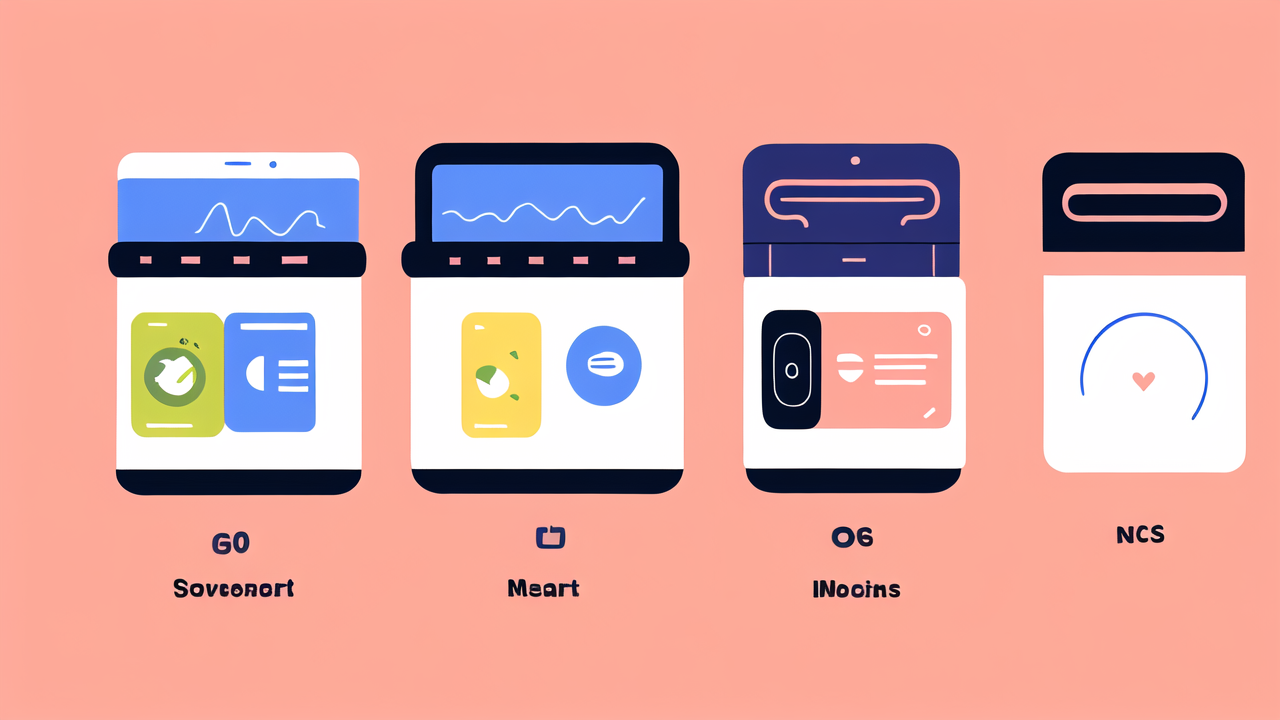Introduction to Smart Watches
Understanding the Basics: What is a Smart Watch?
A smartwatch is a portable device that's often worn on the wrist, much like a traditional watch. However, it offers more advanced features beyond timekeeping. Equipped with various sensors, it can track personal activities, such as steps taken, heart rate, or even sleep patterns. These watches connect to smartphones, giving users notifications for calls, text messages, and app alerts at a glance. Its touch-screen interface allows for seamless interaction and seamless integration into daily life, providing convenience and a host of useful functions right on the user's wrist.

The Rise of Smart Watches in the United States
The smartwatch scene in the United States has seen a remarkable surge over recent years. It wasn't long ago that these high-tech wrist companions were the stuff of sci-fi. Today, they're a common sight, strapped to the wrists of people from all walks of life. This trajectory kicked off when fitness enthusiasts and tech-savvy individuals started strapping on these devices to monitor their health metrics and stay connected on the go. Quickly, the trend caught on, and the smartwatch became a must-have accessory for many. They've evolved from mere novelty items to integral parts of daily life, offering a blend of convenience, connectivity, and style. Companies are fiercely competing to capture the US market, introducing models that cater to a wide array of preferences — from the fashion-conscious to the fitness freaks, ensuring that there's a smartwatch for every American.
History of Smart Watch Development in the US
From Timepieces to Tech Marvels: The Evolution Timeline
The smartwatch revolution has its roots deeply embedded in the rich history of timekeeping innovation. In the United States, this journey began with simple timepieces that evolved into the sophisticated tech marvels we see on wrists today. The evolution timeline is dotted with key milestones that mark the transformation of watches from merely keeping time to becoming extensions of our digital lives.
The 1970s saw the introduction of calculators and digital displays in watches. By the 1990s, companies began experimenting with wireless communication capabilities, leading to the first prototypes of devices that would later be recognized as smartwatches. In the early 2000s, the concept of connected wristwear started to take shape, incorporating more advanced features like touch screens and apps.
The true turning point came with the arrival of smartphones. The seamless integration between the two devices catapulted smartwatches into mainstream consciousness. Advancements in battery life, sensor technology, and mobile connectivity over the past two decades have transformed smartwatches from novel gadgets to essential tools for communication, health monitoring, and personal productivity. Today, we witness a new era where smartwatches not only tell time but also keep us connected to our world in ways once imagined only in science fiction.
Pioneering Brands and Models in the US Market
The history of the smart watch in the United States is marked by several pioneering brands and models that have set the stage for the wearable technology of today. One of the earliest trailblazers was the Pebble Smartwatch, launched through a record-breaking Kickstarter campaign in 2012. Pebble's success paved the way for tech giants to explore the market, leading to the introduction of the Apple Watch in 2015, which quickly became the quintessential smartwatch model globally. Other notable US entries include the Fitbit line, known for merging health tracking with notifications, and the Samsung Gear series, which offered compatibility with a range of Android devices. Each of these models has contributed to shaping the US market, bringing smartwatches from niche gadget status into the mainstream wearable tech scene.
Technological Innovations in Smart Watches
Cutting-Edge Features of Modern Smart Watches
Modern smartwatches boast an impressive array of advanced features that set them apart from traditional timepieces. From high-resolution touchscreens that provide vivid displays to voice assistant integration, enabling users to perform tasks hands-free, these wearable devices are designed for convenience and efficiency. Connectivity options such as LTE and Wi-Fi allow for calls, texts, and app notifications directly on your wrist. Additionally, smartwatches now come with robust health tracking including heart rate monitoring, blood oxygen levels, and even ECG capability. Many offer customizable watch faces and interchangeable bands to match personal style. Sports enthusiasts benefit from GPS tracking and water resistance, making them suitable for a range of activities. Payment technology like NFC allows for contactless payments, and extended battery life ensures that users stay connected for days on a single charge. All these features underscore the remarkable technological strides in the development of modern smartwatches.
How US Companies are Shaping the Future of Wearable Tech
US companies are at the forefront of the wearable technology revolution, shaping the smartwatch industry with their relentless focus on innovation. They are investing heavily in research and development to create smartwatches that not only serve as fashion accessories or mobile notification hubs but also as sophisticated tools for health monitoring, personal assistance, and seamless connectivity. With innovative software platforms and a strategy that encourages third-party developers to create a plethora of applications, American tech giants are pushing the boundaries of what a smartwatch can do. They are integrating advanced sensors to track a wide range of health metrics, from heart rate and sleep patterns to blood oxygen levels and stress. Moreover, companies are embedding artificial intelligence to provide personalised insights that help users lead healthier lives. Connectivity is also being enhanced with the inclusion of LTE and 5G capabilities, making smartwatches increasingly independent of smartphones. Collaboration with fashion brands and incorporation of cutting-edge design principles reflect the US industry's dedication to combining style with utility. By focusing on user experience and expanding the usefulness of wearable tech, US companies are not only leading the market but also paving the way for the future of connected living.
Smart Watch Market Analysis
Analyzing the Current US Market Demographics
The US market for smart watches showcases a diverse range of users spanning various ages, interests, and economic backgrounds. Recent studies indicate that the adoption rate of smart watches is highest among 16 to 34-year-olds, who are tech-savvy and look for devices that integrate seamlessly with their digital lives. Additionally, there's a significant uptick in usage among health-conscious individuals over 50, leveraging these devices for health monitoring purposes. Income levels also play a role, with mid to high-income brackets more likely to invest in premium smart watch models that offer a wide array of functionalities. Urban areas lead in market penetration due to higher tech exposure and availability. This demographic distribution highlights not only the pervasive appeal of smart watches but also the potential areas of growth for companies in the industry.
Consumer Behavior and Trends in Smart Watch Purchases
Smart watches have taken the US by storm, with more consumers embracing this technology each year. Trends in smart watch purchases reveal interesting consumer behavior. People are shifting preferences towards watches that offer a combination of health features, like heart rate monitoring, alongside productivity tools, such as message notifications and calendar reminders. Users are also considering factors like battery life, brand reputation, and compatibility with other devices before making a purchase. The trend towards personalization has led to an increased interest in customizable watch faces and interchangeable straps, enabling users to tailor their devices to fit their style. Notably, the youth market is particularly drawn to smart watches with fitness tracking and social media features. As technology advances, these trends are expected to evolve, further cementing smart watches as a staple in the US tech landscape.
Impact on Health and Fitness
Smart Watches as Health Monitors: The US Perspective
In the U.S., smartwatches have transcended their initial role as timekeepers to become integral health monitors. These wearable devices are now equipped with sensors capable of tracking heart rate, blood oxygen levels, and sleep patterns, providing real-time data that users can leverage to make informed health decisions. They are particularly popular among fitness enthusiasts who appreciate the convenience of monitoring their workouts and overall wellness. The integration of health apps, such as those for meditation and stress management, further solidifies their place in the American health and fitness landscape. By alerting users to potential health issues and encouraging a proactive approach to well-being, smartwatches are becoming a staple in the pursuit of a healthier lifestyle in the United States.
Fitness Tracking: A Revolution in Personal Wellness
Fitness tracking has dramatically transformed personal wellness in the United States. Smartwatches offer an array of sensors that capture data related to physical activity, heart rate, sleep patterns, and even stress levels. This data provides valuable insights, allowing users to set personal goals, monitor their progress, and make informed decisions about their health. With features like step counting, workout tracking, and calorie burn estimation, smartwatches empower people to take charge of their fitness journey. They can also offer motivational prompts and reminders to move, ensuring that users stay active throughout the day. The integration with health apps and platforms means fitness data can be analyzed for trends and shared with healthcare providers, making smartwatches an essential tool in personal health management. As technology advances, we can expect even more sophisticated fitness features, making personal wellness more accessible and tailored to individual needs.
Business and Economy
The Economic Footprint of the Smart Watch Industry in the US
The smartwatch industry has become a significant player in the US economy. With an ever-growing demand for wearable technology, smartwatches have surged in market value and have created numerous economic opportunities. Not only do they represent a booming segment within the consumer electronics market, but they also spur innovation and job creation. As these devices evolve, they integrate more sophisticated technology, drawing in investment and talent. From research and development to sales and marketing, the industry is responsible for a broad spectrum of employment. Major tech companies in the US continue to invest heavily in smartwatch development, signaling a solid belief in the economic viability of these wearables. Moreover, the sector's impact is also felt in the supply chain, with various parts and materials being sourced both domestically and globally, further influencing trade dynamics. The smartwatch industry is not just about selling devices; it's becoming a cornerstone of economic growth, technological advancement, and employment in the United States.
How Smart Watches are Influencing Workforce Productivity
Smart watches have become an integral tool in the modern workplace, reshaping the way employees manage their time and tasks. With features like instant notifications, email and calendar syncing, and task management applications, these wrist-bound devices enable workers to stay connected and organized without constantly reaching for their smartphones or computers. They offer subtle, less disruptive alerts that allow for a less interrupted work flow, boosting concentration and productivity. In addition, the ability to track health metrics such as heart rate and stress levels can encourage better health practices among employees, leading to fewer sick days and heightened overall well-being. Corporations are also capitalizing on the data syncing capabilities of smart watches, which offer seamless integration with enterprise systems, enhancing communication and data sharing among teams. With these advantages, it's clear that smart watches are not just personal gadgets but influential tools powering the workforce's efficiency.
Future Trends and Predictions
Innovations on the Horizon: What’s Next for Smart Watches?
The future of smart watches promises to be thrilling, with advancements that could redefine how we interact with technology on a daily basis. Industry insiders speculate about potential features such as more advanced biometric sensors, offering deeper health insights. We might also see seamless integration with AI, providing personalized feedback and gesture control for enhanced usability. Innovations in battery life and energy efficiency are anticipated, making charging less of a hassle. Moreover, the expansion of standalone capabilities, allowing smart watches to function without a smartphone, is on the horizon. The next generation of smart watches is expected to push the boundaries of connectivity, with some even predicting built-in 5G support for faster and more reliable internet access. Lastly, we can foresee improvements in design, with flexible displays and materials that could lead to a more customized and comfortable wear. Smart watches are set to become more than just gadgets, transitioning into integral components of personal tech ecosystems.
The Role of Smart Watches in the Evolving US Tech Ecosystem
Smart watches are fast becoming an integral component of the U.S. tech ecosystem. As we look to the future, these devices are expected to play a pivotal role in various sectors. For instance, with advancements in technologies like the Internet of Things (IoT), smart watches will likely serve as control hubs for personal and home automation systems. Furthermore, their integration with emerging tech such as augmented reality (AR) will enhance user experiences, making information retrieval and interaction a seamless part of daily life. In the workplace, smart watches will continue to evolve as productivity tools, offering professionals real-time access to notifications, schedules, and even enterprise systems. The collaboration between AI and smart watches holds the potential to bring about sophisticated personal assistants right on the wrist, adapting to users' habits and preferences. Lastly, as communication tech progresses, smart watches could provide more standalone features, reducing dependence on smartphones and marking a shift towards complete wearable autonomy.




Leave a comment
This site is protected by hCaptcha and the hCaptcha Privacy Policy and Terms of Service apply.